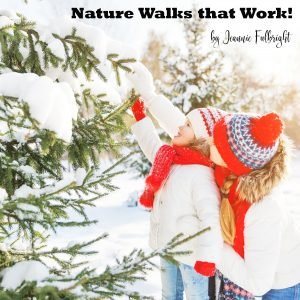Nature Walks That Work!
So we were all told that nature walks were part of Charlotte Mason's education. Upon reading this, many of us promptly bought Comstock's Handbook of Nature Study, packed our pencils and nature journals—one set for each child—and drove to some lovely nature spot to explore and enjoy the beauty of God's creation.
We hoped to open our children's eyes to the magnificence surrounding them and encouraged them to pick something to sketch or about which to write. Unfortunately, our family found it rather dull after a half hour or so. All we saw in nature was an endless trail of weeds, dirt, rocks, and trees. Weed, dirt, rock, tree; weed, dirt, rock, tree; some moss on this rock and that rock; some strange weeds growing here; dirt, rock, tree.

I wondered what it was that made our nature walks such a dismal failure. Are my children and I so used to the fast paced and entertaining world of video and computers that we are unable to focus our attention on the quiet and still wonders of God's creation? The answer, I found, is a resounding NO! That was not the problem at all. The problem was that my children didn't understand nature.
They didn't know what anything was and therefore couldn't enjoy it.
Once we began studying botany, our love of nature literally blossomed. A walk through a forest didn't seem so dull anymore. Each little plant was a wonder to behold, such as the tiny blossoms on that former weed we would never have taken time to notice. We could now discuss how the blossom might be pollinated. Oh! A small fly is crawling around the blossom! Is that the pollinator? Look in the other blossoms. Many other similar flies are found. It must be pollinated by this kind of fly. (After studying zoology, we could identify what kind of fly that was).

Walking a little farther, we saw the moss anew. Look at the small stalks coming out of it with a node on top. They are filled with spores. One spore capsule has broken open. We can look inside with our magnifying glasses. There is some powder in there—moss spores. We wonder where the spores have spread. Can we guess where there might be moss growing next year? We notice that it grows on the north side of the rock. We discuss why this is. We know to look on the north side for more nonvascular plants. A little farther we notice a tree with an odd shaped branch, twisting and turning its way up to the top of the forest. We talk about phototropism. My child decides he wants to sketch that tree for his nature journal. So we all wander around closely while he sketches.
What a blessing to realize we are not completely ruined by videos and computers. We were on a quest that was difficult to enjoy because we didn't understand what we were looking for! I suppose it would be like plopping an alien from another planet down in the middle of Disney World. How would he know there were delights to enjoy at the end of every long line? How would he know what each of those strange characters dressed in odd costumes represented? How would he know that people are happy to get on those rides, thrilled with the whirling, twirling, and splashing they bring? Some basic knowledge is necessary to really enjoy both Disney World and nature.
It blesses me that I have been used by God to make nature walks a delight for others.
One homeschool mom told me, "My oldest son was playing with Hot Wheels cars beside our tree when he noticed that all the branches on the ground have lichen on them. 'Wow, Mom...now that we know all this new stuff, we're realizing it's so IMPORTANT! Before, we just thought it was nothing but strange bark.'"
To enhance your nature walks, I can't recommend enough the study of botany. Whether you use Apologia's Young Explorer Series (which I wrote) or another botany curriculum, I encourage you to immerse yourself in this amazing field of study so that your children can experience the joy of discovery when they see up close in nature the things they have studied.
Read more about Charlotte Mason’s methodologies.
Learn more about and see samples of my science series.


